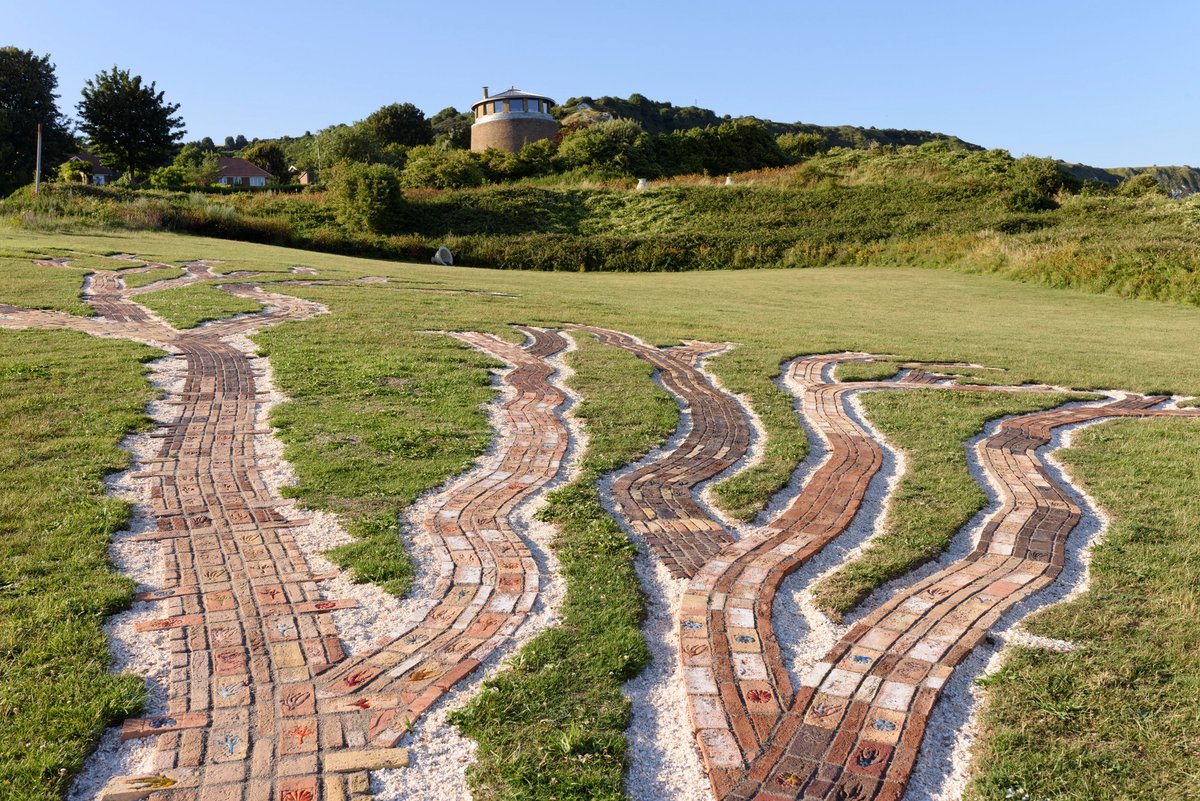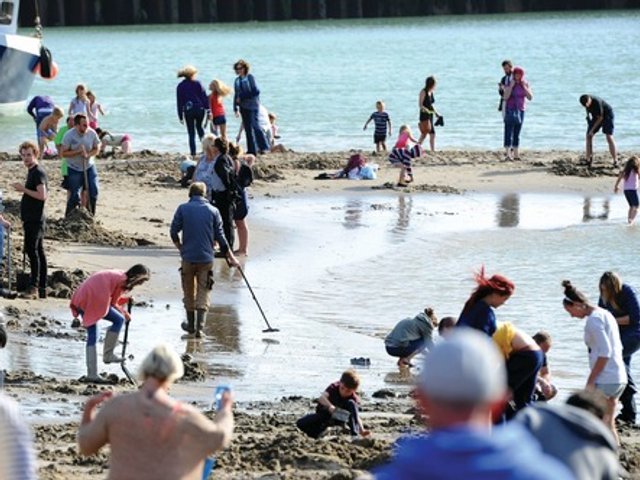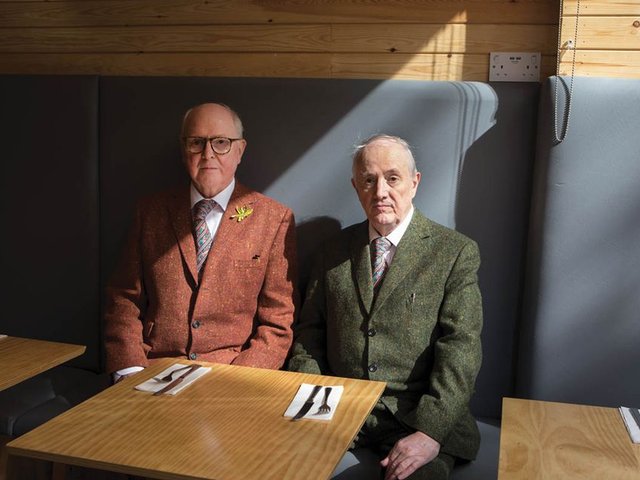It is a reflection of our close relationship to the landscapes we inhabit that “the lie of the land” has become a general term for taking the measure of things, for gauging a situation and assessing what needs to be done. This phrase is the starting point for the 18 artists taking part in the sixth edition of the Folkestone Triennial, spread around the seaside town in southeast England. The ancient port has long been a site of arrival and departure, but as much of the outstanding work in this triennial reveals, there is nothing fixed or static about the lie of Folkestone’s terrain.
The deep connection of Folkestone’s early inhabitants to their physical surroundings is celebrated by Sara Trillo in Urn Field, a series of dramatic sculptures on the East Cliff inspired by ceramic urns excavated at a nearby Iron Age settlement. Made from chalk cob—a prehistoric building material combining chalk from the surrounding cliffs with stones, sand and straw—these scaled up shards mirror the colour and the fragility of the local geology. And unlike most of what we produce today, they will gently break down and be incorporated back into the environment. Each piece is named after wild plants growing on this piece of waste ground, including plantain, mugwort, wild carrot and blackthorn—all of which once had a medicinal role that has now been largely disregarded or forgotten.
Entombment of a more toxic kind is explored in Emilija Skarnulyte’s film Burial, screening at the Quarterhouse. The piece offers an immersion in the empty halls of the Ignalina Nuclear Power Plant in Lithuania, which was originally the sister plant to Chernobyl. Now Ignalina is being laboriously decommissioned and its radioactive uranium rods given a deep burial that will not, however, prevent them from being potentially lethal for generations to come. Dramatic scenes of hazmat-suited figures dismantling the plant’s vast chambers are cut with disquieting images of a snake slithering through its control rooms. The futility of attempts to cover humanity’s toxic tracks is underscored by the looming presence of the two nuclear power stations at nearby Dungeness, visible from Folkestone, which are also undergoing the long process of being decommissioned as the UK government is planning new nuclear power plants to help hit net zero targets.
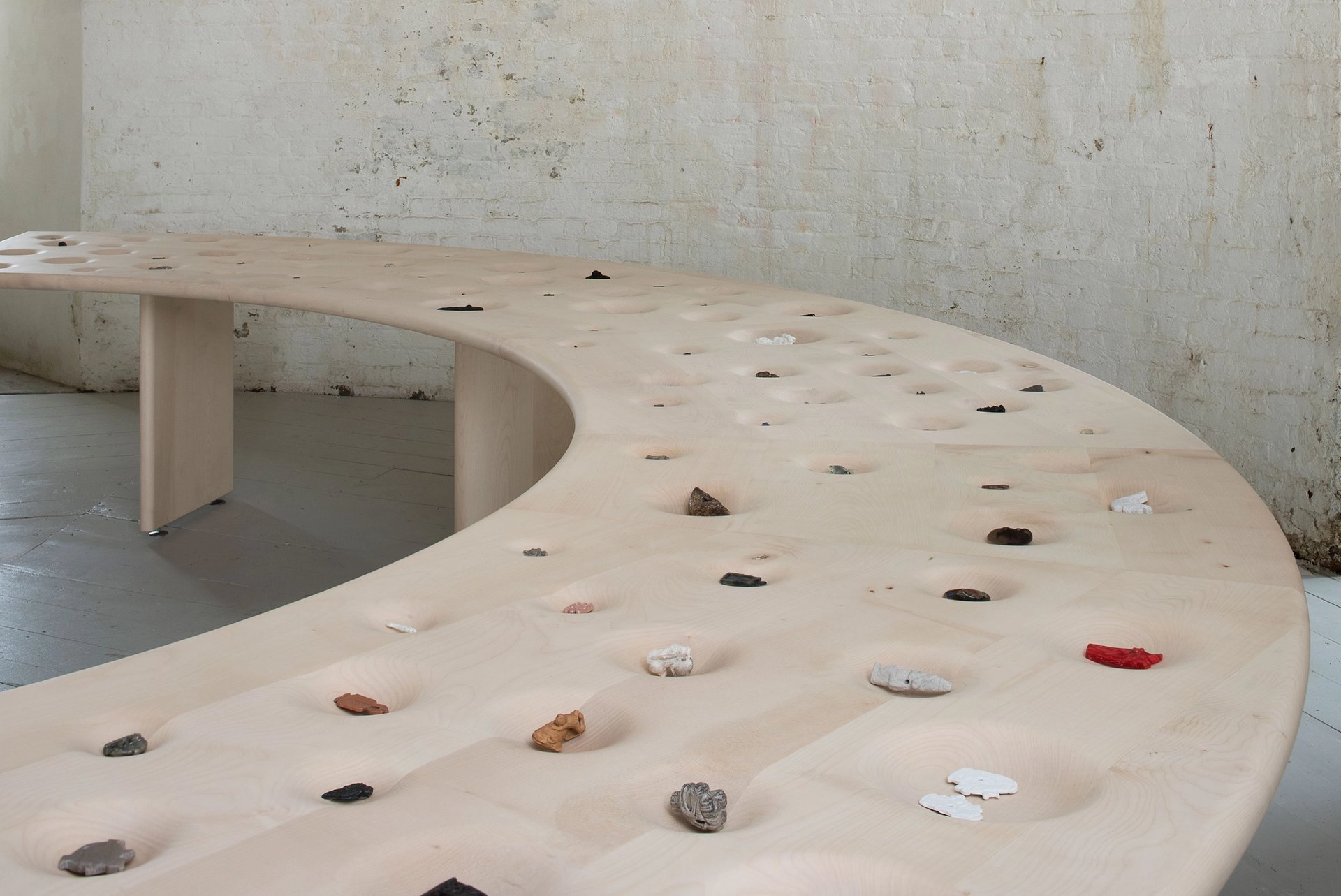
Katie Paterson's Afterlife installation is on show in Folkestone's Martello Tower Creative Folkestone Triennial 2025. Photo: Thierry Bal
Small in size but perceived as powerful objects that can ward off danger, amulets have been made and used by cultures and civilisations worldwide. In Afterlife, one of the triennial’s most profound and thought-provoking works, Katie Paterson revisits and inverts this time-honoured tradition with casts of nearly 200 amulets from a mind boggling range of periods and places. Each of the charms has been scanned and recast in materials that carry the evidence of our planetary crisis, from an Olmec corn amulet made from neoprene fibres, which will lurk in our ecosystems for millennia, to a pair of netsuke birds fashioned using regurgitated plastic from a starving baby albatross. The message is loud and clear: no part of the planet is free from human contamination, and it will only be actions, not lucky charms or wishful thinking, that will save us.
In the former Customs House building on the Harbour Arm, direct action is being taken against the ongoing pollution and mismanagement of the UK’s sewerage system. At the Ministry of Sewers, set up by the collective Cooking Sections in collaboration with local activists, visitors can share their concerns and stories about water pollution. The organisers are hoping to build up an archive of evidence that can be used to prosecute water companies and other polluters. The abundance of testimonies, slogans and visual evidence—both playful and serious—that already lines the walls confirms the popular support for this marriage of art and activism. One deliciously irreverent addition is a fountain-sculpture depicting the former UK prime minister Margaret Thatcher perpetually swigging a glass of filthy water.
Polluted or not, the sea dominates both the town of Folkestone and the triennial. Jennifer Tee’s Oceans Tree of Life, is composed of handmade bricks adorned with images of marine life. By arranging these variegated bricks in frond-like shapes, Tee pays tribute to the vital but threatened forests of kelp growing along the UK’s coast, which are also a crucial sequester of carbon. The various sea creatures, both extinct and living, that decorate the bricks, along with the chalk on which they sit, are a reminder that it is the fossilised remains of primeval waterborne creatures that make up much of the surrounding geology—and that it is impossible to deny our interconnectedness with all aspects of the environment.
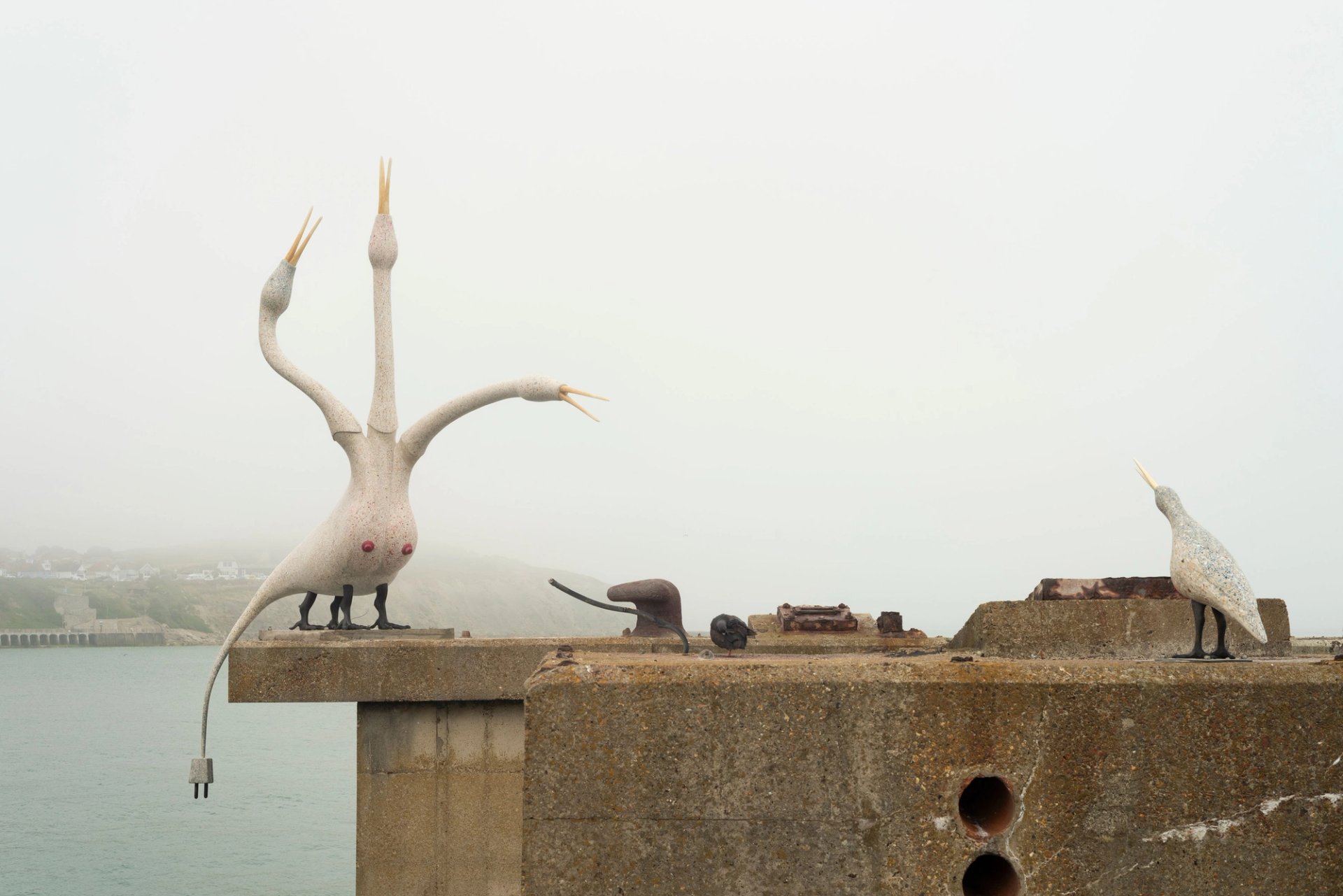
Laure Provost's Above Front Tears, Oui Connect Creative Folkestone Triennial 2025. Photo: Thierry Bal
Let’s also not forget that Britain was once attached to mainland Europe until the rising of sea levels around 8,000 years ago created our southeastern coastlines. Down on the harbour Laure Provost pays tribute to this lost connection with a pair of sculptures dramatically positioned on the concrete piers that once supported a ramp for cars boarding ferries to France. Here a freakish three-headed bird with pink human nipples and an electrical plug for a tail, raises two of its sharp beaks to the sky, and extends a third towards her baby on the neighbouring pier. Poised on Folkestone’s watery threshold and capable of looking in three directions at once, Provost’s mythical mashup inhabits many different states. According to the artist this bizarre creation is also closely linked to another pair of Provost beasties situated across the Channel on the coasts of Belgium and France.
More drama and ambiguity can be found in Dorothy Cross’s sculpture Red Erratic, occupying a loading bay at the water’s edge that is only accessible at low tide. Hyper-realistic human feet have been carved out of the massive block of flesh-red marble and during high tide they seemingly float on the water. The stone comes from Syria, a country shaped by migration and conflict, while “erratic” is the geological term for a rock moved by a glacier to a new place. Cross has created a magnificent anti-monumental monument to hope, horror, displacement and the weight of history. And surely Red Erratic must be allowed to remain in situ after the triennial is over.
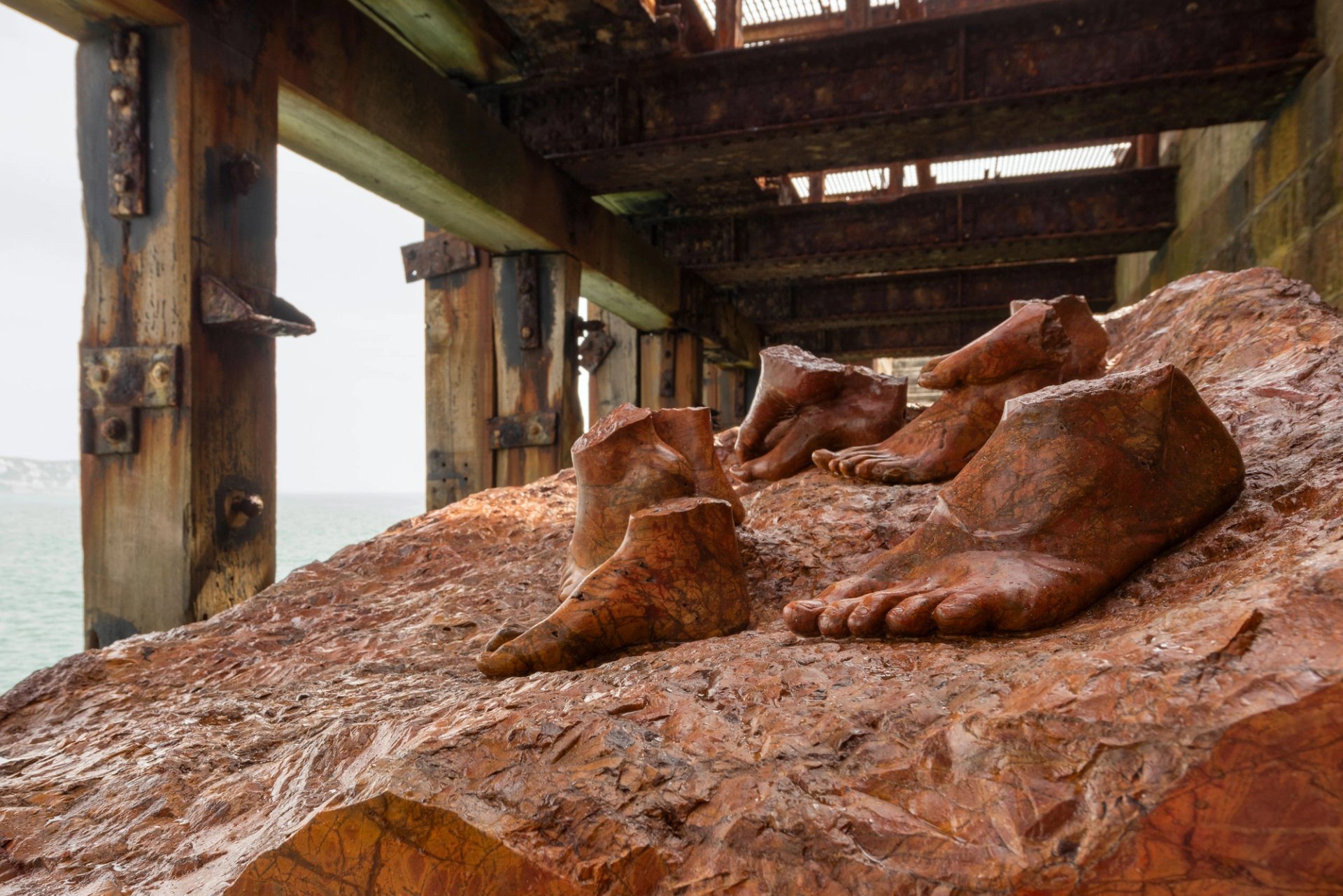
Dorothy Cross’s Red Erratic Creative Folkestone Triennial 2025. Photo: Thierry Bal
As much of the work in this triennial points out, the lie of the land both in Folkestone and beyond seems rife with peril and precarity. But there are also strong glimmers of hope. Sarah Wood’s film Prospect reveals and reframes hitherto unseen footage shot by Derek Jarman in and around his magical garden conjured out of the bleak shingle in the shadow of Dungeness B nuclear power station. Projected into a corner of a soulless office development, these glimmering fragments pay homage to the remarkable man and offer an enduring beacon of humanity and resilience.
The sheer power of the sea to conjure up mixed and visceral memories is harnessed by Emeka Ogboh in Ode to the Channel. The stirring sound piece is experienced on the seafront where the pounding of waves is deftly interspersed with the voices of local singers as they pay tribute to the many roles that the small but significant stretch of sea has played as both a passageway and a contested space. Ogboh’s multisensory work also includes a lemony artist-designed ice cream and a can of specially brewed Doggerland beer, whose name pays tribute to the UK’s submerged but enduring links with Europe.
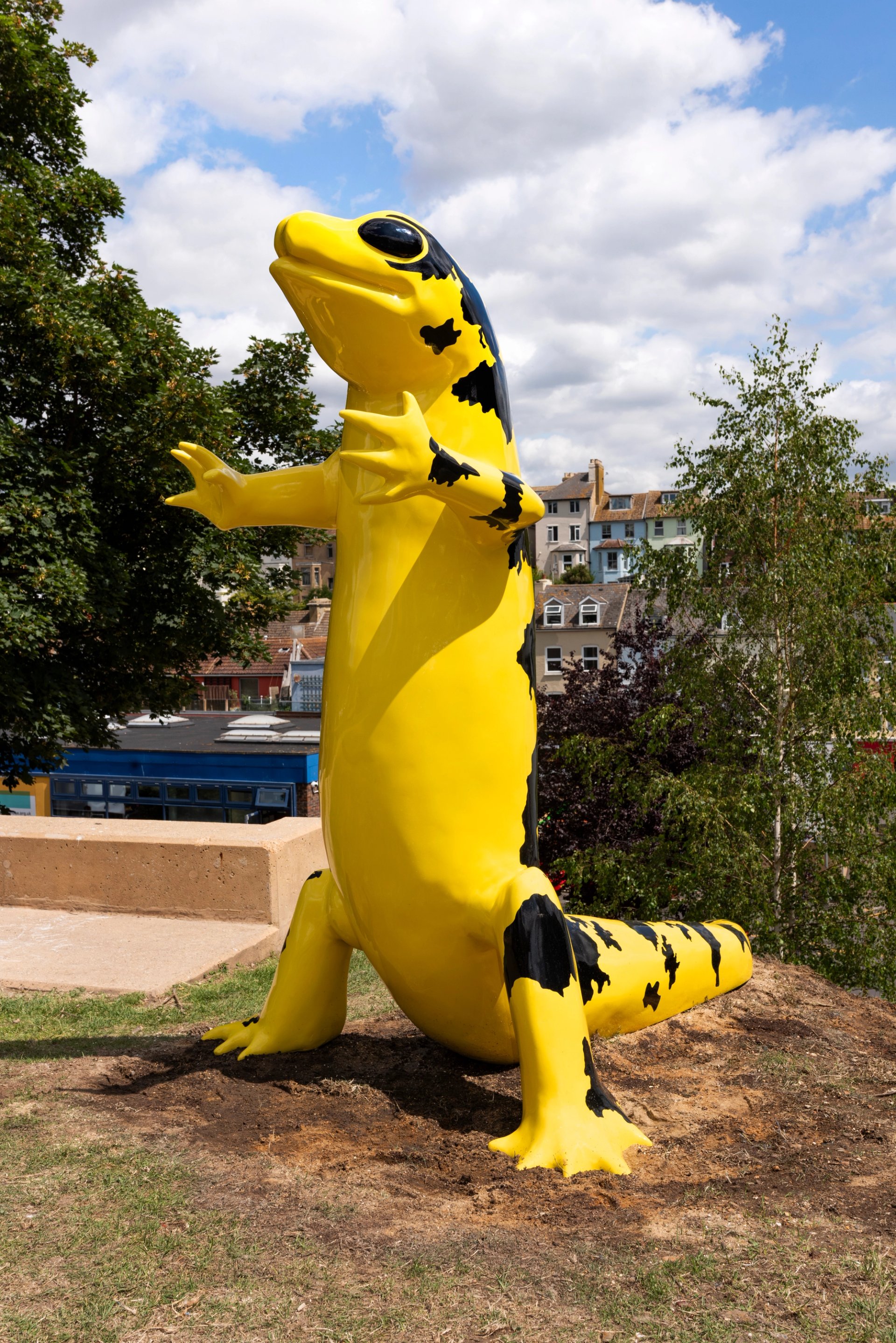
Monster Chetwynd’s sculpture of a yellow and black salamander in Folkestone's Payers Park Commissioned for Creative Folkestone Triennial 2025. Photo: Thierry Bal
But for me the most enduring symbol of optimism and renewal is Monster Chetwynd’s larger than life sculpture of a yellow and black salamander, which perches above the town in Payers Park. This vivid creature, renowned for its extraordinary ability to self-regenerate, is the first harbinger of a fantastical playground being created by Chetwynd, which will sit at the heart of a newly reinvigorated Folkestone town centre. Here, surrounded by more exuberant salamanders supporting slides, swings and climbing frames, visitors of all generations and backgrounds can channel the power of both art and play to imagine, and hopefully bring about, a better world and a healthier lie of the land.
• Folkestone Triennial: How Lies the Land? various venues, Folkestone, until 19 October


